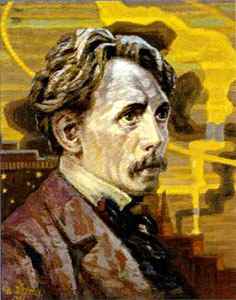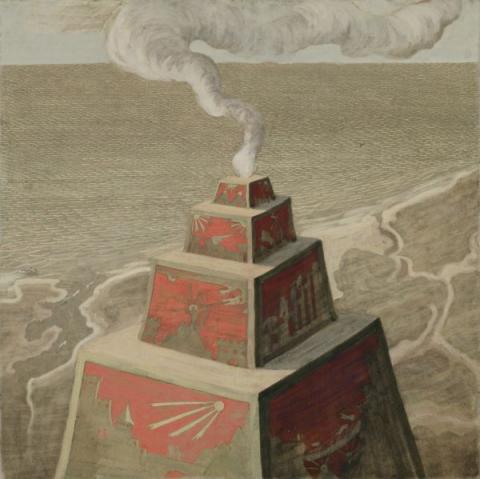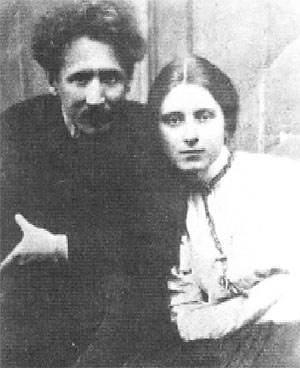
Mikalojus Konstantinas Čiurlionis

To commemorate the 100th anniversary of the death of Lithuanian artist and composer Mikalojus Konstantinas Čiurlionis (1875–1911) Semplice and the Institute of Lithuanian Literature and Folklore presents his musical heritage in Europeana.
As well as being a famous artist, Ciurlionis is also probably the best known Lithuanian classical composer. His musical philospohy was adopted as the guiding principle behind the Lithuanian national composers‘ school. Ciurlionis' compositions for piano (1900–1909) are the most perfect and original part of this composer's musical heritage, reflecting the idiosyncracy of his style. Polyphonic structure, basso ostinato, polyrhythm and serial techniques are the composer‘s favorite tools.Ciurlionis used the sought the powerful voice of the organ to express his idea of the 'world as a grand symphony.' "I want to compose a symphony out of rolling waves, the mysterious conversations of the secular woods, the twinkling of the stars, of our old songs, and my boundless longing“, wrote Čiurlionis in a letter to his fiancee.
Ciurlionis created almost as many (about 300) paintings as he did musical compositions. His painting skills emerged at the Warsaw Academy of Art, where he studied for a short while after completing his musical studies. His unusually individual style of painting reflects more an inner flair than an acquired technique.
Ciurlionis began to paint when he was already a mature composer – he brought his musical sensibilities and approach into his painting. He used principles of music composition in his artwork, giving musical terms to some of his paintings, referring to them as preludes, fugues and sonatas. The compositional structure of the three or four-part sonata is most often present in his work. The frequent repetition of motifs, the melodic rhythm of lines, and the playful harmony of colours also connects his painting to his music.
Ciurlionis felt deeply the natural beauty of Lithuania, fascinating and dream-like in its nuances of gentle colours, and he incorporated this dimension in his paintings. Lithuania’s nature and the world outlook of the Lithuanian nation are reflected in all his principal works. He was acquainted with this outlook through his intimate knowledge of the people’s way of life and customs, folk tales and songs.
 |
Ciurlionis was born in Varena, southern Lithuania, where his father was organist. Three years later his father moved to Druskininkai, a health resort on the Nemunas, to take up the post of organist. It was in the delicate and dreamlike natural surroundings of Druskininkai here Ciurlionis grew up and frequently spent his holidays. Taught by this father, he could read music without any difficulty at the age of seven. He continued his musical education at Prince Oginski’s orchestra school in Plunge, and was later (1893 – 1899) able to attend the Warsaw Conservatory of Music with the Prince’s support, studying piano and composition.
When Ciurlionis graduated from the Conservatory, he was offered the position of director of the Lublin School of Music, but chose instead to earn a living by giving private lessons. He again received the support of Prince Oginski, and was able to attend the Leipzig Conservatory of Music,.
 |
When he returned to Warsaw in the autumn of 1902, he was again offered a teaching post at the Conservatory, but continued to give private lessons. He became interested in the principles of painting, finding that painting satisfied the requirements of his imagination, teeming as it was with images from the Bible, the ancient Hinduism, the works of Tagore, Ruskin, Wilde, Kipling, Merezhkovsky, and others.
Ciurlionis’ paintings were put on display at the first Lithuanian art exhibition (Dec. 27, 1906 to Feb. 15, 1907) in Vilnius. In the autumn of 1908 he went to St. Petersburg, hoping to improve his living conditions, but his initial visit was not successful and he returned to Lithuania in 1909 to marry the young writer Sofija Kymantaitė-Čiurlionienė. He was not materially well off, and was unable to afford buy paints; later the same year he became mentally ill due to overwork. Ciurlionis was taken to a sanatorium near Warsaw - after initially showing signs of improvement, he caught a cold and died unexpectedly on April 10, 1911.
Included in the Europeana collection are his symphonic poems 'In The Forest'(1900–1901) and 'The Sea' (1903–1907), in which dramaturgy and majestic conception acquire philosophical overtones.
Find out more:
- Ciurlionis in Europeana
- www.ciurlionis.eu.
- Semplice, Lithuania
- Ciurlionis' great-grandson, pianist Rokas Zubovas, celebrates the music of his forebear.
Text by the Institute of Lithuanian Literature and Folklore and Museums of Lithuania
